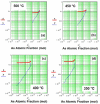Isotherm Theoretical Study of the AlxGa1-xAsySb1-y Quaternary Alloy Using the Regular Solution Approximation for Its Possible Growth via Liquid-Phase Epitaxy at Low Temperatures
- PMID: 36554116
- PMCID: PMC9777770
- DOI: 10.3390/e24121711
Isotherm Theoretical Study of the AlxGa1-xAsySb1-y Quaternary Alloy Using the Regular Solution Approximation for Its Possible Growth via Liquid-Phase Epitaxy at Low Temperatures
Abstract
This work presents the theoretical calculation of isotherm diagrams for quaternary alloys of III-V semiconductor compounds with the form IIIxIII1-xVyV1-y. In particular, the isotherm diagrams for the AlxGa1-xAsySb1-y quaternary alloy at low temperatures were calculated (500 °C, 450 °C, 400 °C, and 350 °C). The AlxGa1-xAsySb1-y quaternary alloy was formed from four binary compounds such as GaAs, AlAs, AlSb, and GaSb, all with direct bandgaps. The regular solution approximation was used to find the quaternary isotherm diagrams, represented in four linearly independent equations, which were solved using Parametric Technology Corporation Mathcad 14.0 software for different arsenic and antimony atomic fractions. The results support the possible growth of layers via liquid-phase epitaxy in a range of temperatures from 500 °C to 350 °C, where the crystalline quality could be improved at low temperatures. These semiconductor layers could have applications for optoelectronic devices in photonic communications, thermophotovoltaic systems, and microwave devices with good crystalline quality.
Keywords: LPE; isotherm diagram; regular solution approximation; semiconductor compound.
Conflict of interest statement
The authors declare no conflict of interest.
Figures



References
-
- Rowell J.M. The advantages of transmitting light signals instead of electrical ones have led to ultrapure glass, semiconductor alloys only a few atoms thick and “nonlinear” materials that are now revolutionizing communications. [(accessed on 21 July 2022)];Photonic Mater. Sci. Am. 1986 4:146–157. Available online: http://www.jstor.org/stable/24976065.
-
- Gastellóu E., García G., Herrera A.M., Morales C., García R., Hirata G.A., Robles M., Rodríguez J.A., García I.E. A Brief Review of Growth Techniques for Obtaining of III-V Semiconductor Compounds. Eur. J. Eng. Res. Sci. 2019;4:17–21. doi: 10.24018/ejers.2019.4.9.1477. - DOI
-
- Schneider K., Welter P., Baumgartner Y., Hahn H., Czornomaz L., Seidler P. Gallium Phosphide-on-Silicon Dioxide Photonic Devices. J. Light. Technol. 2018;36:2994–3002. doi: 10.1109/JLT.2018.2829221. - DOI
-
- Milanova M., Kakanakov R., Koleva G., Vitanov P., Bakardjieva V., Zamoryanskaya M., Popova T. High-Quality GaInAsSb and GaAlAsSb Layers for Thermophotovoltaics Grown by Liquid-Phase Epitaxy. Solid State Phenom. 2010;159:87–90. doi: 10.4028/www.scientific.net/SSP.159.87. - DOI
LinkOut - more resources
Full Text Sources
Research Materials

